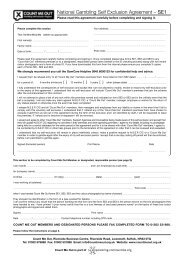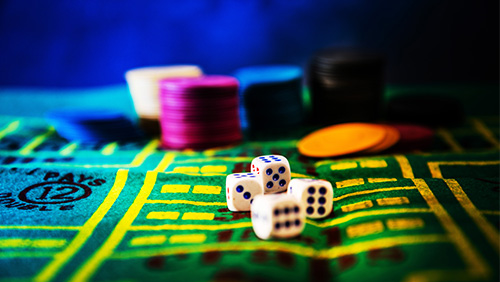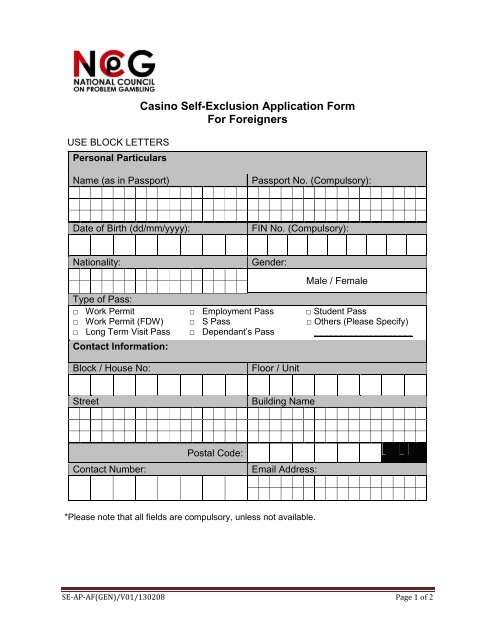- Singapore Casino Self Exclusion Status Check
- Singapore Casino Self Exclusion Status Requirements
- Singapore Casino Self Exclusion Status Template
- Singapore Casino Self Exclusion Status Application
The second phase of the Harvard study, as reported in the article, “One decade of self exclusion: Missouri casino self-excluders four to ten years after enrollment,” focused on the effectiveness of the MVEP by assessing the experiences of a sample of Missouri self-excluders for as long as 10 years after their initial enrollment in the.
- Casino Exclusion Orders. What are the different types of Casino Exclusions available? Please click here for more information. How do I apply for a casino self-exclusion order? If you are a Singapore Citizen or Permanent Resident here, you can apply for self-exclusion using your SingPass. Click here to apply for it.
- This can be a signature on a self-exclusion form. I never signed an exclusion form, technically i am not bound to there exclusion policy only what the UKGC have provided in good practice for casino's to follow which deems there polices inefficient with UKGC's guidelines. Social responsibility code provision 3.5.1 Paragraph 6 (A.).

Self-exclusion is one of the most widely used responsible gaming strategies. These programs allow individuals to literally “exclude” themselves from a gaming venue as a way of dealing with problematic gambling behavior. Scientific research on the safety and effectiveness of self-exclusion is just now catching up to the establishment of such programs, which began more than a decade ago.
The NCRG’s Aug. 16 webinar, “Regulating Interventions for Disordered Gambling: What New Research Says about the Safety, Effectiveness and Logistics of Self-Exclusion Programs,” will feature research by Robert Ladouceur, Ph.D., C.A.S., professor of psychology, Laval University, Quebec. (Click here for more details or to register for this free, one-hour program.) This month’s Issues & Insights highlights selected peer-reviewed studies in this emerging area of research.
Self-exclusion programs provide a way for a person to voluntarily ban him or herself from a casino as a way to deal with a gambling problem. These programs can be mandated by the government or voluntarily established by casinos and other gaming operators. For example, casinos that are members of the American Gaming Association, which represents commercial casinos in the United States, are required by the association’s Code of Conduct to provide their guests with the option to self-exclude. Under most self-exclusion agreements, the individual risks trespassing charges if she or he attempts to return to the casino and forfeits any winnings. The casino agrees to remove the self-excluded person from its direct mail lists, and many programs require a lifetime ban. However, some governments and casinos are experimenting with shorter bans because clinicians and researchers have expressed concerns that a lifetime ban may prevent people from enrolling.
Researchers are interested in what motivates an individual to enroll in a self-exclusion program because the act of enrollment represents treatment-seeking behavior. Since only a fraction of the population with a gambling problem seeks external assistance, understanding why gamblers choose to enter a self-exclusion program will help inform treatment strategies for disordered gambling. A 2010 study, “Motivators for resolving or seeking help for gambling problems: A review of the empirical literature,” found that self-excluders were motivated by a weighing of the pros and cons of gambling and the desire to regain control over their gambling as well as concern about the impact on relationships and financial difficulties (Suurvali, Hodgins, & Cunningham).
The Missouri Gaming Commission, which created the Missouri Voluntary Exclusion Program (MVEP) in 1995, has made its data available to researchers, resulting in several publications. For example, researchers analyzed the Missouri enrollment data from the perspectives of age and gender (Nower & Blaszczynski, 2006, 2008). In “Characteristics of problem gamblers 56 years of age or older: A statewide study of casino self-excluders,” they reported that older adult self-excluders typically began gambling in midlife, experienced gambling problems around age 60, reported preferences for nonstrategic forms of gambling (e.g., slot machines) and identified fear of suicide as the primary reason for enrolling in the MVEP (Nower & Blaszczynski, 2008). In another study of the MVEP, “Characteristics and gender differences among self-excluded casino problem gamblers: Missouri data,” Nower and Blaszczynski observed that female self-excluders were more likely than males to be African American, older at time of application, and either retired, unemployed or otherwise outside the traditional workforce (2006). In addition, female self-excluders were more likely to report a later age of gambling onset, a shorter period between onset and self-exclusion, a preference for non-strategic forms of gambling and prior bankruptcy.
The Harvard Medical School faculty at the Division on Addictions, Cambridge Health Alliance, conducted a two-phase research project on the MVEP. As reported in “Missouri casino self-excluders: Distributions across time and space,” a geographic and time-based analysis of the 6,599 people who applied to exclude themselves from Missouri casinos between 1996 and 2004 demonstrated that the epicenters of disordered gambling were the Western region around Kansas City and the Eastern region around St. Louis (LaBrie, Nelson, LaPlante, Peller, Caro, & Shaffer, 2007). The authors observed that the annual number of self-exclusion enrollments increased during the first few years of the MVEP before leveling off during the later years, suggesting a process of adaptation to the presence of casinos in Missouri.
The second phase of the Harvard study, as reported in the article, “One decade of self exclusion: Missouri casino self-excluders four to ten years after enrollment,” focused on the effectiveness of the MVEP by assessing the experiences of a sample of Missouri self-excluders for as long as 10 years after their initial enrollment in the program (Nelson, Kleschinsky, LaBrie, Kaplan, & Shaffer, 2010). According to this study, most of the self-excluders had positive experiences with MVEP and reduced their gambling and gambling problems after enrollment. However, half of the 15.9 percent of the self-excluders succeeded in trespassing at Missouri casinos after enrollment, indicating that the benefit of MVEP was attributable more to the act of enrollment than enforcement.
Dr. Robert Ladouceur and his colleagues at Laval University also have conducted extensive research on the effectiveness of self-exclusion. Their studies of a self-exclusion program in a Quebec casino demonstrated the promise of this approach for helping individuals reduce problem gambling behaviors (Ladouceur, Jacques, Giroux, Ferland, & Leblond, 2000; Ladouceur, Sylvain & Gosselin, 2007). Their most recent study (Tremblay, Boutin, & Ladouceur, 2008) is the first to evaluate efforts to make self-exclusion a therapeutic program (e.g., providing counseling support to enrollees) rather than just a legal agreement about trespassing. The authors observed major improvements in the study sample between the initial and final evaluation in terms of the amount of time and money they spent gambling, the consequences of their gambling, scores on the criteria for diagnosing pathological gambling and levels of psychological distress.
Such findings appear to support the notion of self-exclusion as a gateway to treatment. In their 2007 publication, Blaszczynski, Ladouceur, and Nower argued for a unifying structure for self-exclusion programs as a gateway to treatment based on a system operated by independent educators. These educators would inform individuals of the purpose of self-exclusion, establish links and access to supplementary services and monitor and report the effectiveness of the overall program.
Although these studies reveal the promise of self-exclusion, all identify the need for larger sample sizes in future research to determine more definitively the effectiveness of self-exclusion as an intervention for disordered gambling.
Despite this interest in self-exclusion as a therapeutic program or harm reduction strategy, self-exclusion programs administered by governments are technically considered legal agreements with penalties for self-excluders who violate the terms of the contract. For example, self-excluders can be arrested for trespassing or fined if caught on the premises of a casino in many jurisdictions. Self-exclusion has raised questions among legal specialists about the responsibility and liability of the gaming operator. Self-excluders have initiated lawsuits in cases where the casino did not enforce the ban (Faregh, & Leth-Steensen, 2009; Czegledy, 2009). Questions such as, “Who is responsible if a self-excluded person gains entry to a casino and goes bankrupt?” and “Should casinos withhold winnings from self-excluded patrons?” have been posed in several court cases (Rhea, 2005). Some also have questioned whether self-exclusion agreements even meet the legal standards of an enforceable legal contract (Napolitano, 2003).

Although most of the peer-reviewed research on self-exclusion is focused on the U.S. and Canada, studies on this intervention have been conducted all over the world. Both peer-reviewed and “grey” literature (publications that are not peer-reviewed, such as government reports) indicate that self-exclusion has been studied in Australia, New Zealand, Switzerland, South Africa and the United Kingdom (Breen, 2005; Townshend, 2007; Haefeli, 2005; O'Neil, Whetton, Dolman, et al., 2003; Collins, & Kelly, 2002; Jackson, & Thomas, 2005).
If you are interested in learning more about self-exclusion research, note that two upcoming educational programs will focus on translating several of the studies cited above for a non-scientific audience. First, Dr. Robert Ladouceur will present his findings from the self-exclusion program in Quebec during the NCRG Webinar, “Regulating Interventions for Disordered Gambling: What New Research Says about the Safety, Effectiveness and Logistics of Self-Exclusion Programs.”This free, one-hour webinar will be held onAug. 16, 2010, at 2 p.m. (EDT), and also will feature Kevin Mullally, J.D., general counsel and director of government affairs at Gaming Laboratories International,and the developer of Missouri Voluntary Exclusion Program. Advance registration is required.
Second, the next volume of the NCRG’s publication series, Increasing the Odds: A Series Dedicated to Understanding Gambling Disorders, focuses on research about self-exclusion, providing summaries of several of the articles cited above, written for a non-scientific audience. This free publication will be available in October 2010.
References
Blaszczynski, A., Ladouceur, R., & Nower, L. (2007). Self-exclusion: A proposed gateway to treatment model. International Gambling Studies, 7(1), 59-71.
Breen, H., Buultjens, J., & Hing, N. (2005). Evaluating implementation of a voluntary responsible gambling code in Queensland, Australia. International Journal of Mental Health & Addiction, 3(1), 15–25.
Collins, P. & Kelly, J. (2002). Problem Gambling and Self-Exclusion: A Report to the South African Responsible Gambling Trust. Gaming Law Review, 6(6), 517-531.
Czegledy, P. (2009). The Legal Risk of Problem Gambling. Gaming Law Review and Economics, 13(3), 233-240.
Haefeli, J. (2005). Swiss experience with self-exclusion programs. Presented at the Niagara Falls Self Exclusion Panel, Niagara Falls. Retrieved from http://www.responsiblegambling.org/articles/jorg_hafeli_discovery_2005.pdf
Jackson, A., & Thomas, S. (2005). Clients' perspectives of, and experiences with, selected Australian problem gambling services. Journal of Gambling Issues, 14. Retrieved from http://jgi.camh.net/doi/full/10.4309/jgi.2005.14.7
LaBrie, R. A., Nelson, S. E., LaPlante, D. A., Peller, A. J., Caro, G., & Shaffer, H. J. (2007). Missouri casino self-excluders: distributions across time and space. Journal of Gambling Studies, 23(2), 231-243.
Ladouceur, R., Jacques, C., Giroux, I., Ferland, F., & Leblond, J. (2000). Analysis of a casino's self-exclusion program. Journal of Gambling Studies,16(4), 453-460.
Ladouceur, R., Sylvain, C., & Gosselin, P. (2007). Self-exclusion program: a longitudinal evaluation study. Journal of Gambling Studies, 23(1), 85-94.
Napolitano, F. (2003). The self-exclusion program: legal and clinical considerations. Journal of Gambling Studies,19(3), 303-315.
Nelson, S. E., Kleschinsky, J. H., LaBrie, R. A., Kaplan, S., & Shaffer, H. J. (2010). One decade of self exclusion: Missouri casino self-excluders four to ten years after enrollment. Journal of Gambling Studies,26(1), 129-144.
Nower, L., & Blaszczynski, A. (2006). Characteristics and gender differences among self-excluded casino problem gamblers: Missouri data. Journal of Gambling Studies,22(1), 81-99
Nower, L., & Blaszczynski, A. (2008). Characteristics of problem gamblers 56 years of age or older: a statewide study of casino self-excluders. Psychology and Aging, 23(3), 577-584.
O'Neil, M., Whetton, S., Dolman, B., Herbert, M., Giannopoulos, V., O'Neil, D., & Wordley, J. (2003). Evaluation of Self-exclusion Programs. South Australian Centre for Economic Studies. Retrieved from http://www.justice.vic.gov.au
Rhea, A. (2005). Voluntary Self Exclusion Lists: How They Work and Potential Problems. Gaming Law Review, 9(5), 462-469.
Suurvali, H., Hodgins, D.C., & Cunningham, J.A. (2010). Motivators for resolving or seeking help for gambling problems: A review of the empirical literature. Journal of Gambling Studies, 26, 1-33.
Singapore Casino Self Exclusion Status Check
Townshend, P. (2007). Self-exclusion in a Public Health Environment: An Effective Treatment Option in New Zealand. International Journal of Mental Health and Addiction, 5(4), 390-395.
Ruling
Found for the Casino - Genting may have some provision arrangement with FSB but operate on their own license and would not share self exclusions.
Singapore Casino Self Exclusion Status Requirements
Read our Genting Casino Review.
Player's Complaint
I opened an account with Genting but have now found out they have a white label agreement with FSB. I have previously self excluded from that group and therefore request that my deposits are refunded. They have stated that they are not part of FSB and therefore don’t have access to their database. This is in contradiction to Blacktype who hold a separate GC license but still have access to the FSB database and have identified previously that I have self excluded from a company within the FSB white label group.
Singapore Casino Self Exclusion Status Template
1 Response
Hi steele321 - welcome to ThePOGG.com!

Unfortunately there's nothing we can do to help you in this instance. While Genting may have some provision agreement with FSB to provide games, payments or other services, they operate on their own UKGC license. This means that they manage their player database independently of FSB and do not share player details with this company. As such a self exclusion at an FSB managed property would not carry over to Genting.
Sorry we cannot be of more help.
ThePOGG
Singapore Casino Self Exclusion Status Application
Leave a Reply
You must be logged in to post a comment.